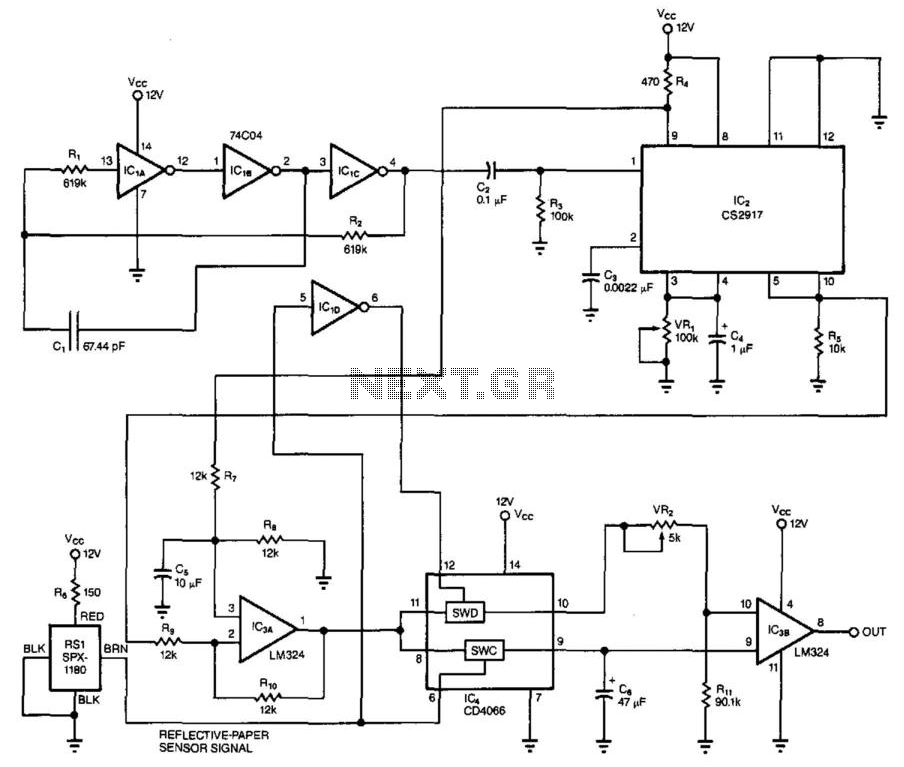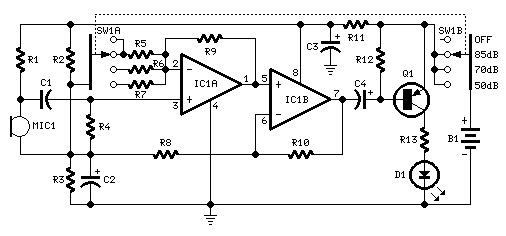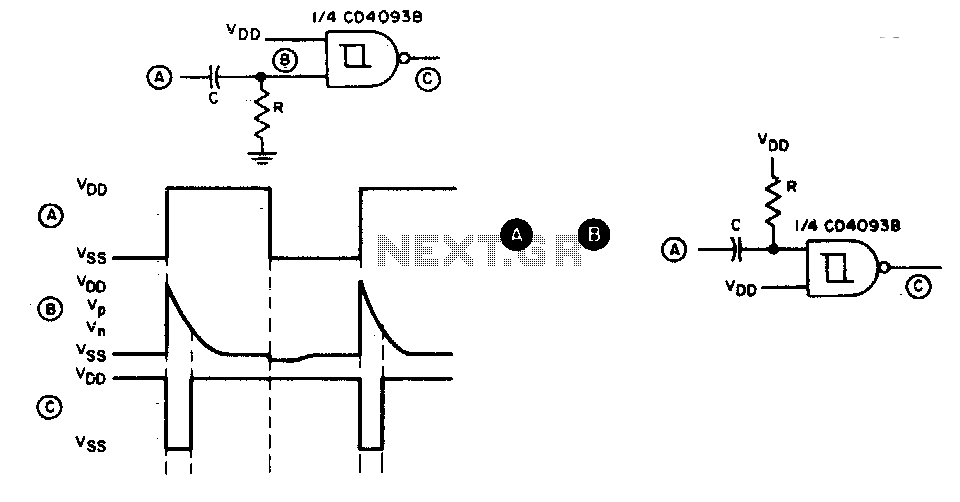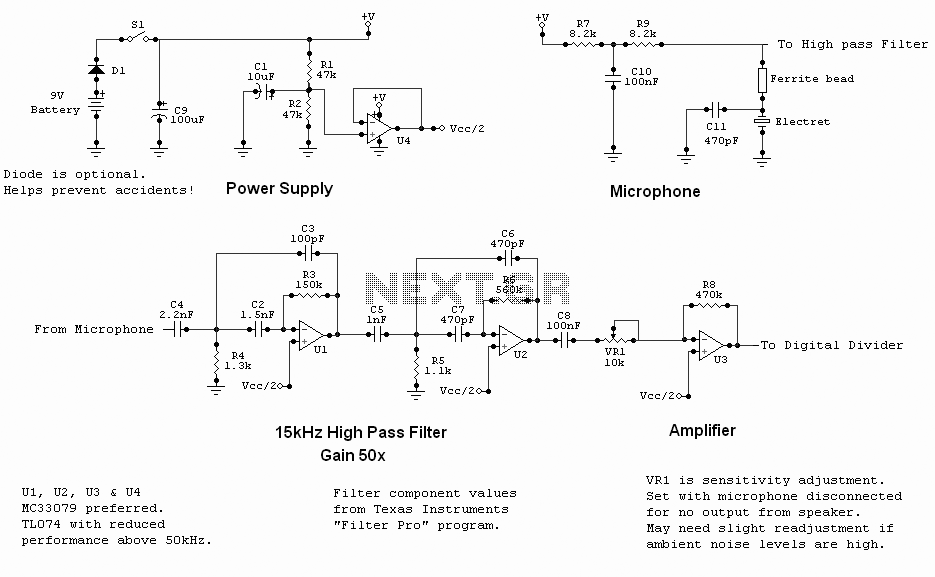
Static charge-electricity detector
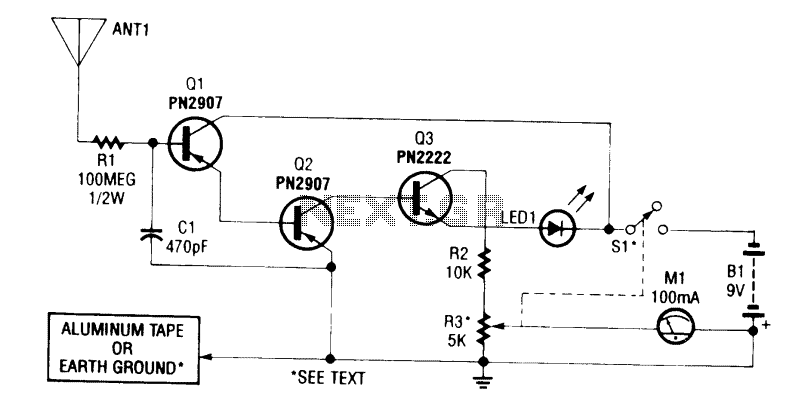
The detector is designed to sense static charges and free ions present in the air. It can indicate the presence of ion emissions, high voltage, static electricity, and electrostatic fields. The grounding can be achieved through an earth ground or by touching a metal object with the hand. The meter operates within a 100 µA range, and the R3 potentiometer is used to control the sensitivity of the detector.
The electronic schematic for this detector consists of several key components that work together to achieve its functionality. The core of the circuit includes a sensitive meter that operates on a 100 µA range, allowing it to detect minute currents associated with static charges and ion emissions. The meter is connected in series with a sensing element that can detect the presence of static electricity and free ions in the environment.
The sensing element is typically a field-effect transistor (FET) or a specialized ion sensor that responds to changes in electric fields. When static charges or free ions are present, they induce a voltage change across the sensing element, which is then translated into a current that drives the meter.
To enhance the performance of the detector, a potentiometer (R3) is included in the circuit. This component allows for the adjustment of the sensitivity of the detector, enabling it to be calibrated for different environments or applications. By varying the resistance of the potentiometer, the threshold at which the detector responds to static charges can be modified, making it adaptable to various levels of ion emissions or static electricity.
The grounding method is critical for the accurate operation of the detector. It can either be connected to an earth ground, providing a stable reference point, or it can utilize a metal object that can be touched by the user. This flexibility allows the circuit to function effectively in different settings, whether in a laboratory or an industrial environment.
Overall, the design of this static charge and ion detection circuit emphasizes sensitivity and adaptability, making it a valuable tool for measuring electrostatic fields and ensuring safety in environments where static electricity may pose a risk.The detector will sense static charges and free ions in the air. It can be used to indicate the presence of ion emission, high voltage, static electricity, and electrostatic fields. The ground can be an earth ground or a touching metal by your hand. The meter is 100uA range and R3 potentiometer is by controlling the sensitivity of the detector.
The electronic schematic for this detector consists of several key components that work together to achieve its functionality. The core of the circuit includes a sensitive meter that operates on a 100 µA range, allowing it to detect minute currents associated with static charges and ion emissions. The meter is connected in series with a sensing element that can detect the presence of static electricity and free ions in the environment.
The sensing element is typically a field-effect transistor (FET) or a specialized ion sensor that responds to changes in electric fields. When static charges or free ions are present, they induce a voltage change across the sensing element, which is then translated into a current that drives the meter.
To enhance the performance of the detector, a potentiometer (R3) is included in the circuit. This component allows for the adjustment of the sensitivity of the detector, enabling it to be calibrated for different environments or applications. By varying the resistance of the potentiometer, the threshold at which the detector responds to static charges can be modified, making it adaptable to various levels of ion emissions or static electricity.
The grounding method is critical for the accurate operation of the detector. It can either be connected to an earth ground, providing a stable reference point, or it can utilize a metal object that can be touched by the user. This flexibility allows the circuit to function effectively in different settings, whether in a laboratory or an industrial environment.
Overall, the design of this static charge and ion detection circuit emphasizes sensitivity and adaptability, making it a valuable tool for measuring electrostatic fields and ensuring safety in environments where static electricity may pose a risk.The detector will sense static charges and free ions in the air. It can be used to indicate the presence of ion emission, high voltage, static electricity, and electrostatic fields. The ground can be an earth ground or a touching metal by your hand. The meter is 100uA range and R3 potentiometer is by controlling the sensitivity of the detector.
